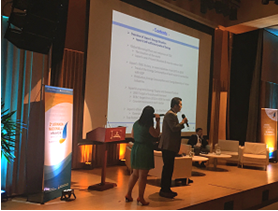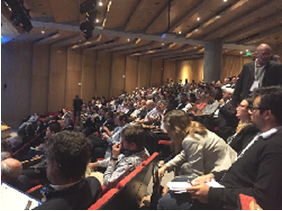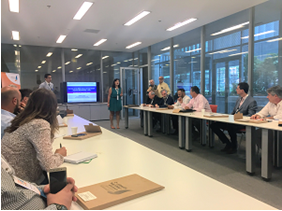ECCJ participated in EE&C workshop (Sponsored by the Argentine Government) associated with the IDB
Under the entrustment of the IDB (Inter-American Development Bank), the Energy Conservation Center, Japan (ECCJ) participated in the workshop on energy efficiency & conservation (EE&C) (Day of the national Energy Efficiency i.e. Jornada Nacional de Eficiencia Energetica) hosted by the Ministry of Energy and Mining, held in Buenos Aires, Argentina on November 23, 2017 to give a lecture on the outline of an EE&C policy in Japan and the features of the Top Runner Program, one of the model examples thereof. Likewise at a simultaneously held governmental EE&C committee, the ECCJ gave a lecture on the EE&C history of Japanese steel industry to share the information with the government and industry participants trying to build a collaborative relationship with them.
Hosted by the MINEM (Ministry of Energy and Mining), Argentina, the Workshop was held in order to enhance EE&C promotion in Argentina. Judging from the fact that number of responsible staff for EE&C in the ministry has increased more than 3 times than a few years ago, it is anticipated that EE&C activities are to be accelerated greatly in the near future in Argentina.
(1) At the Session for the industrial sector (audience: approx. 250 people)
The ECCJ explained the history of the establishment of EE&C structure focusing on the Japanese EE&C Act, recent status of EE&C promotion, recognition of future issues, and so on. The audience was impressed very much by the fact that the efforts done in the past 40 years resulted in 40% reduction of the Energy Intensity.


Lecture at the workshop of the Energy Efficiency Day
(2) At the Governmental EE&C committee (side event) (audience: 40 people)
Intended for the government officials and steel industry EE&C practitioners, the ECCJ gave a lecture on the history of the establishment of EE&C structure of the steel industry, reasons for its success, and so on. It was fully understood by the audience that introduction of pre-emptive production and process technologies and the most effective operation thereof led to realize the EE&C structure as well as increased production, and that there were very close public-private partnerships in the background, including the financial supports by the governments. It is duly understood that the Japanese steel industry is struggling now for more EE&C because of the great achievement in the past.

Lecture at energy conservation committee sponsored by the government

